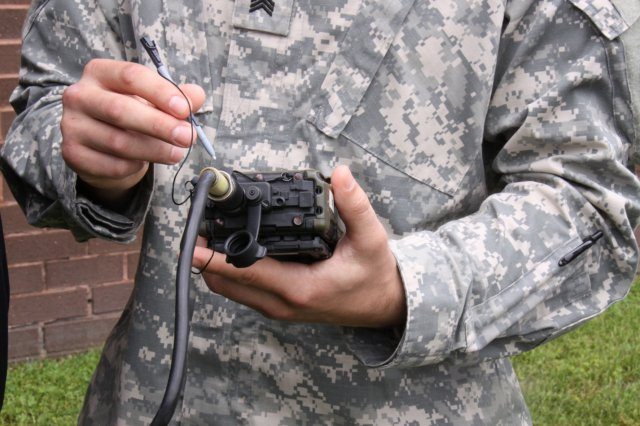Project Director, Communications Security is moving closer to fielding a new handheld device which will be used to deliver electronic keys to secure the Army’s phone, radio, computer and satellite networks.
The Next Generation Load Device-Small, or NGLD-Small, comes with a new digital display on the front and is smaller than previous devices used for encryption, but still gives the same security protection as larger devices. It replaces older models that were no longer able to handle the Army’s encryption key delivery requirements.
“The NGLD are a family of devices, with a small, medium and large version,” said Aaron Clayton, the Tier 3 Fill Devices project leader at Project Director, Communications Security, or PD COMSEC, which is assigned to the Army Program Executive Office for Command, Control, Communications-Tactical, or PEO C3T. “Those don’t relate to their physical size but their capabilities. The NGLD-Small in particular is targeted to replace a legacy device that Soldiers currently use. The legacy device doesn’t have the security features that we would like to see today like the NGLD-Small can provide.”
The NGLD devices are used to receive, store, manage and export electronic keys that are used for cryptography. The keys are loaded into communications devices such as radios and satellite terminals to secure networks.
When building or procuring a new device such as an NGLD-Small, PD COMSEC must account for many factors because of the secure information involved.
“These devices are certified by the National Security Agency (NSA) to be able to handle and store electronic keys classified up to the Top Secret level,” Clayton said. “We work very closely with the NSA to make sure what we’re doing is in sync with their security requirements.”
PD COMSEC also has to ensure the devices can stand up to the wear and tear put on them by Soldiers during a deployment. To ensure that the devices can meet the vigorous environmental requirements, the PD COMSEC team took several samples of potential NGLD-Small devices to the Network Integration Evaluation, or NIE, at Fort Bliss, Texas, and White Sands Missile Range, N.M., where troops conduct realistic mission threads in order to evaluate communications equipment in an operational environment.
“We took approximately 10 of each device with us and they all came back with the paint worn off and all scratched up, but they still worked,” Clayton said.
At first, Soldiers appeared reluctant to use the new device over the larger, yet more familiar, Simple Key Loader, or SKL, they had used previously. Those devices were able to provide the security required, but were larger, and at times more cumbersome than the NGLD-Small.
“We had trainers come in with the different devices and teach the Soldiers how to use them,” said Stan Scofield, PD COMSEC special projects officer for the PEO C3T Technical Management Division. “It didn’t take very long to get them up and running on the new devices. Once they learned how to use them and got to see some of the upgrades, they didn’t want to give them back.”
While the Soldiers were happy with the new devices, there is still potential for improvement that PD COMSEC will recommend to manufacturers. These improvements will ensure that Soldiers have every advantage possible while securing military networks in hostile environments.
“We got a lot of feedback and found some shortcomings in the new devices,” Clayton said. “We’re making suggestions for enhancements to the device so they will meet Army requirements. We want to make sure they can completely load, interface and configure the new Army software defined radios.”
Clayton said he believed the new devices should be field ready by the end of the year.










